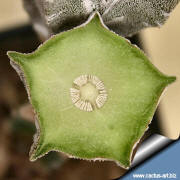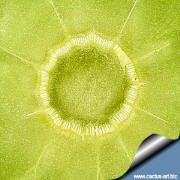
Cross section of a
stem of
Astrophytum myriostigma
The cortex is the pale green tissue between the outer
epidermis and the
stele (
vascular bundles)
in the centre.

Stele of
Echinocactus grusonii
whit cortical
bundles branching
off from cauline bundles and from leaf/bud traces. |
The
particularity of the Cactus Cortex
Cacti have a particular increased cortex width
in which the photosynthetic outer cortex is farther away from
the vascular bundles of the stem (Stele) Most cacti still have a
relatively narrow pith, so in broad, globose
barrel cacti the
epidermis and
chlorenchyma are often several
centimetres (and
as much as 40 cm in Ferocactus and
Echinocactus) from the
xylem
and phloem of the shoot’s vascular bundles. Over such distances,
diffusion of water is extremely slow, diffusion of
sugars is even slower. Even with an extremely thick covering of
cuticle and
wax, any
epidermis will lose some water to dry
desert air, and that water must be replaced rapidly if the
epidermis and outer cortex tissues are to remain alive. Rapid
translocation throughout the voluminous cortex of many cacti is
made possible by the presence of a specific system of collateral
cortical bundles.
Cortical bundles branch off from stele bundles and from
leaf/bud
traces, then run outward, tangentially and upward through the
cortex, branching extensively and vascularizing all regions of
the cortex. Cactus cortex is long-lived, cortical bundles must
also function for many years. In all species, cortical bundles
produce secondary phloem, and in very old bundles at the base of
very old shoots, the amount of collapsed secondary phloem can be
many millimeters thick.
In contrast the ability of other
plants not belonging to the
Cactaceae to produce extra
cortical tissues is
extremely limited by its inability to vascularize them.
Consequently other
stem-photosynthetic plants
and succulents such as euphorbias,
pachypodiums, stapeliads never become as broad as cacti do. It
is certainly popular to point out the
convergent evolution
between euphorbias and cacti, but no euphorbia ever becomes as
broad as a barrel cactus, or even as broad as many smaller
cacti. The reason is simple: none of the non-cactus
stem-photosynthetic succulents have cortical bundles in their
stems. They are free to evolve to have a wider, more voluminous
cortex only up to the point at which diffusion from the stele
becomes too slow to keep the epidermis healthy. One of the
broadest euphorbias,
E. obesa, achieves its width by widening
its stele: it has a broad
pith that spreads its set of vascular
bundles into a ring with a wide diameter, which is in turn
surrounded by a cortex that is only moderately thick. But
storing water in pith is more difficult than storing it in the
cortex because a pith can absorb a large amount of water and
swell only if the wood is flexible, otherwise either the wood
would be torn apart or the pith would be prevented from
expanding enough to absorb much water |